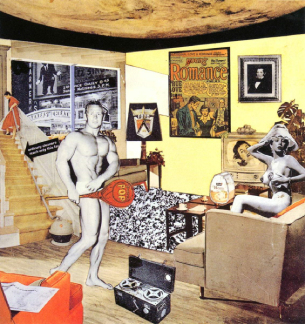Pop art emerged in the 1950s in Britain and the United States. The Pop art movement challenged the traditions of fine art by including imagery from popular culture such as advertising, news, etc. In pop art, material is sometimes visually removed from its known context, isolated, and/or combined with unrelated material. The concept of pop art refers not as much to the art itself as to the cultural and social attitudes that led to it. Pop art employs aspects of mass culture, such as advertising, comic books and everyday cultural objects. It is widely interpreted as a reaction to the then-dominant ideas of abstract expressionism,

 | |
|
The popart movement main influence include Dadaism (collage and photo montage), cubism (abstraction) and surrealism. Pop art is aimed to employ images of popular notion as opposed to the traditional art form. It emphasises on the banal or kitschy elements of society, most often through the use of irony.Key Characteristics of Pop Art
Two important painters in the establishment of America's pop art vocabulary were Jasper Johns and Robert Rauschenberg. While the paintings of Rauschenberg have relationships to the earlier work of Kurt Schwitters and other Dadaists, his concern was with social issues of the moment. His approach was to create art out of common materials and using topical events in the life of everyday America gave his work a unique quality. Johns' and Rauschenberg's work of the 1950s is classified as Neo-Dada, and is visually distinct from the classic American Pop Art which began in the early 1960s. Of equal importance to American pop art is Roy Lichtenstein. His work probably defines the basic premise of pop art better than any other through parody. Selecting the old-fashioned comic strip as subject matter, Lichtenstein produces a hard-edged, precise composition that documents while it parodies.

CARACTERISTICS
· Recognizable imagery, drawn from popular media and products.
· Usually very bright colours.
· Flat imagery influenced by comic books and newspaper photographs.
· Images of celebrities or fictional characters in comic books, advertisements and fan magazines.
· In sculpture, an innovative use of media
Another important figure for the pop art movement was the American born artist Andy Warhol. He is famous for his re interpretation of commercial product imagery (Campbell soup) and also the use of popular figures and celebrities (silkscreen prints of Marylyn Monroe) made him no less than an icon of the style.
References
http://arthistory.about.com/od/modernarthistory/a/Pop-Art-Art-History-101-Basics.htm
http://guity-novin.blogspot.com/2010/06/chapter-33-pop-art.html
http://speckyboy.com/2012/01/16/20-things-you-didn%E2%80%99t-know-about-pop-art-
graphic-design/
The Thames and Hudson
Dictionary of Graphic
design and Designers
1992-98 Thames and Hudson Ltd, London UK
All
accessed 23/1/2014 2100
No comments:
Post a Comment